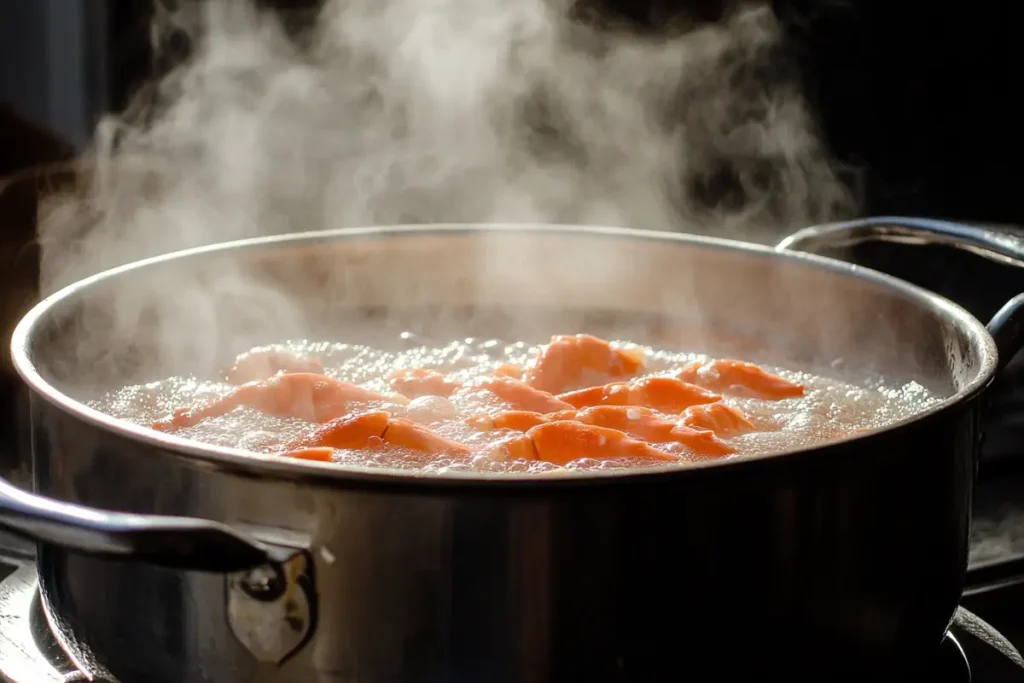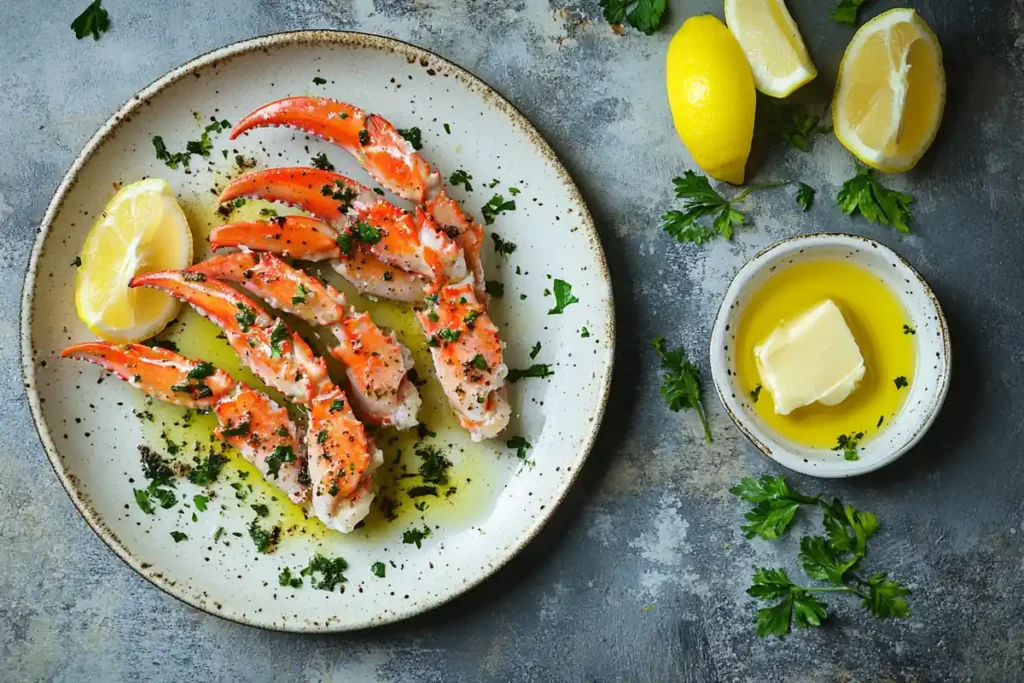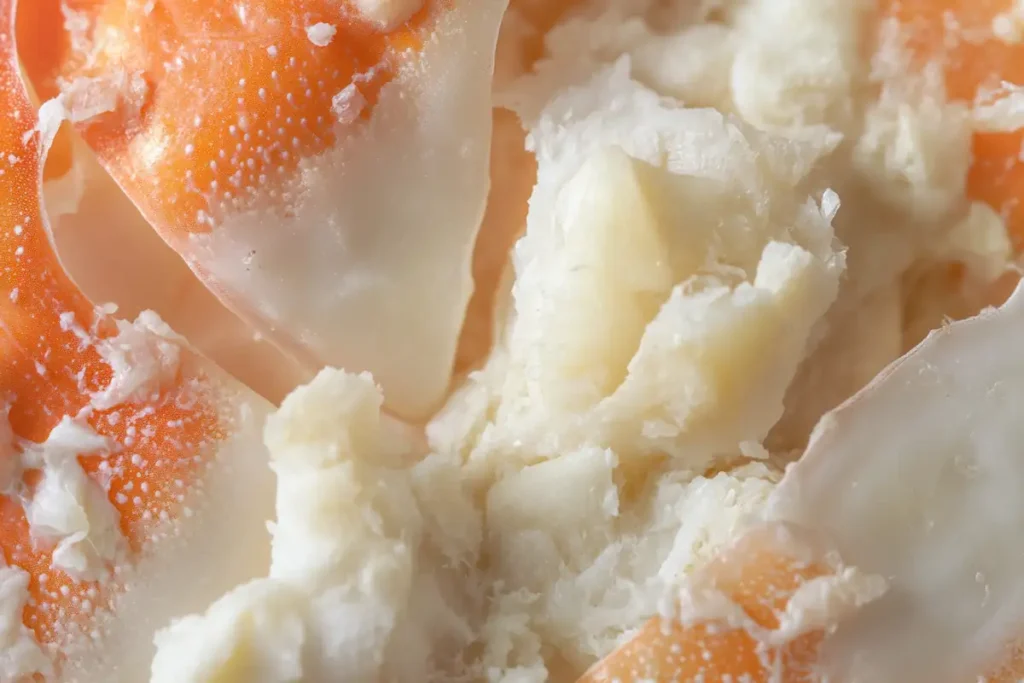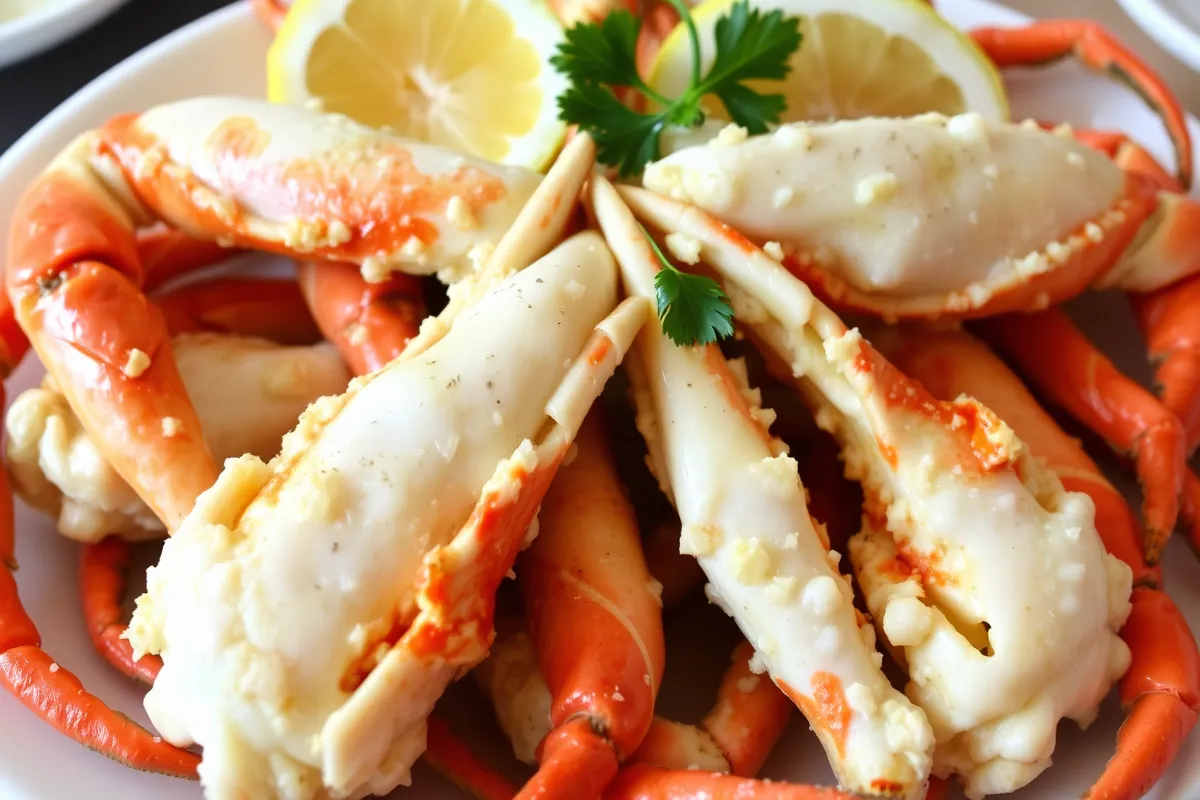Snow Crab Legs are a culinary delight often enjoyed for their tender, sweet meat and ease of preparation. In this article, we’ll explore what makes snow crab claws so special, where they come from, their nutritional value, how to cook them, and more. By the end, you’ll know exactly why snow crab claws are such a sought-after dish and how you can prepare them to perfection.
Outline
Introduction: Understanding Snow Crab Legs
- Overview of snow crab claws
- Why they are popular in the United States
- Brief introduction to their flavor and texture
What Are Snow Crab Claws?
- Description of snow crab species
- Habitat and characteristics of snow crabs
- Differences between snow crab claws and other types of crab legs
Where Do Snow Crab Legs Come From?
- Locations where snow crabs are found
- Fishing methods for snow crab claws
- Environmental concerns and sustainability practices
Snow Crab Legs vs. King Crab Legs
- Main differences between snow crab and king crab
- Taste, size, and texture comparison
- Price and availability
Nutritional Value of Snow crab claws
- Macronutrients and micronutrients
- Health benefits of snow crab meat
- How they fit into a balanced diet
How to Cook Snow Crab Claws
- Boiling method
- Steaming method
- Grilling method
- Step-by-step recipes for each cooking technique
Snow Crab Leg Recipes
- Classic butter-dipped snow crab claws
- Snow crab leg pasta
- Spicy snow crab leg boil
How to Select and Buy Snow Crab Claws
- What to look for when buying fresh or frozen crab legs
- Seasonal availability and pricing
- Best places to buy snow crab claws
Storing Snow Crab Claws
- Proper methods for storing fresh and cooked snow crab claws
- Tips on how to keep them fresh longer
Health Considerations and Tips for Enjoying Snow Crab Claws
- How to ensure Snow crab claws are safe to eat
- Potential allergens and dietary restrictions
- Enjoying snow crab claws on a keto or low-carb diet
Frequently Asked Questions About Snow Crab Claws
- What’s the difference between snow crab and crab legs?
- What are snow legs?
- What is in snow crab?
- What are crab legs?
Conclusion
- Summary of key points
- Why snow crab claws should be on your next dinner menu
What Are Snow Crab Claws? The Complete Guide to Understanding This Delicacy
Snow crab claws are a delicacy enjoyed for their delicate flavor, tender texture, and ease of cooking. Whether served in a classic butter sauce or as part of a larger seafood boil, snow crab claws offer a versatile, delicious option for seafood lovers.
Snow crabs are typically caught in cold waters such as those in the North Atlantic and North Pacific oceans. They are valued for their sweet, succulent meat, which is found mainly in the legs and claws. Unlike the more robust king crab, snow crabs have smaller, more delicate legs, making them easier to handle and prepare. This article will cover everything you need to know about snow crab claws—from their nutritional value to the best cooking methods, ensuring your next crab feast is a memorable one.
Understanding Snow Crab Claws
Snow crab claws come from a species of crustacean known as Chionoecetes opilio, which is native to the cold waters of the North Atlantic and North Pacific. These crabs are smaller than king crabs, and their legs are known for being much easier to crack open, making them perfect for an easy-to-enjoy seafood experience.
What are snow crab claws so popular? Their sweet and mild flavor, combined with tender meat, makes them a favorite among seafood enthusiasts. Also, they are relatively more affordable compared to other types of crabs, making them a popular choice for gatherings and special occasions.
Snow crabs are caught using traps set on the ocean floor, which helps minimize the impact on the environment compared to trawling methods used for other seafood.
Various external organizations and resources offer valuable insights into different crab species and their ecological roles. Moreover, these platforms not only contribute to a deeper understanding of sustainable harvesting but also highlight the importance of conservation practices, thereby ensuring the long-term health of snow crab populations and their habitats. Consequently, this information can help guide responsible consumer choices. Furthermore, it promotes environmental stewardship by encouraging practices that protect marine ecosystems
What Are Snow Crab Claws?
Snow crab claws are harvested from the snow crab species, which are found in the icy waters of the northern oceans. They are well-known for their spindly, elongated legs that contain sweet, juicy meat. Snow crab claws are different from king crab legs in terms of size, texture, and taste.
Snow Crab vs. Other Crab Legs: Snow crabs have thinner shells compared to king crabs, making them easier to crack. This quality is ideal for those who love seafood but don’t want to put in the effort of using special tools. Furthermore, snow crab claws have a more consistent flavor, which many people find appealing.
Snow crabs primarily live on the seafloor, where they thrive in temperatures between -1 to 5 degrees Celsius. They are typically harvested using pots or traps that are less damaging to the ocean habitat than other fishing techniques.
Snow Crab Legs vs. King Crab Legs
When comparing snow crab claws to king crab legs, there are several key differences that you should know before making your choice. Firstly, the most noticeable difference is size. King crabs are much larger and heavier, with thicker legs that require special tools to crack open. In contrast, snow crabs have slender, delicate legs that are easier to handle. Additionally, the flavor profiles of the two crabs are distinct, which is another important aspect to consider
- Texture and Taste: Snow crab meat is tender and has a delicate sweetness, while king crab meat is known for its rich, firm texture.
- Price and Availability: Snow crab claws are generally more affordable than king crab legs, making them more accessible for larger gatherings or frequent meals.
Snow crab claws are also preferred by many for their milder taste, which pairs well with a variety of seasonings and dipping sauces. Whether you prefer the tender texture of snow crab or the robust meatiness of king crab, both have their unique advantages.
Nutritional Value of Snow Crab Claws
Snow crab claws are not only tasty but also nutritious. In fact, they are an excellent source of protein, containing about 19 grams per 100 grams of meat, which is great for maintaining muscle mass and energy levels. Moreover, they are relatively low in calories, with just 85 calories per 100 grams. Therefore, incorporating snow crab into your diet can be a healthy and delicious choice
Vitamins and Minerals: Snow crab claws are rich in essential nutrients like vitamin B12, selenium, and zinc. Vitamin B12 is crucial for maintaining healthy nerve and blood cells, while selenium plays a role in antioxidant defense. Additionally, they contain omega-3 fatty acids, which are beneficial for heart health.
How to Cook Snow Crab Legs

Snow crab legs are incredibly versatile and can be prepared using various methods to bring out their delicious flavor. Below are some popular ways to cook them:
1. Boiling Snow Crab Claws
Boiling is perhaps the most common method of cooking snow crab claws. It’s straightforward and ensures that the crab meat remains tender and juicy.
Instructions:
- Fill a large pot with water and add salt.
- Bring the water to a boil.
- Place the snow crab claws in the pot and cook for 5-7 minutes.
- Remove and serve with melted butter.
2. Steaming Snow Crab Claws
Steaming preserves the flavor better than boiling since the crab legs don’t come into direct contact with the water.
Instructions:
- Fill a pot with about two inches of water and place a steamer basket inside.
- Bring the water to a boil.
- Add the crab legs to the basket and steam for 5-6 minutes.
3. Grilling Snow Crab Legs
Grilling adds a smoky flavor to the crab legs and is ideal for summer barbecues.
Instructions:
- Preheat your grill to medium heat.
- Brush the crab legs with olive oil.
- Grill for 4-5 minutes on each side.
Snow Crab Leg Recipes

Here are a few delicious recipes that make the most of snow crab claws:
Classic Butter-Dipped Snow Crab Claws
This is a classic recipe that enhances the natural sweetness of snow crab claws.
Ingredients:
- 2 pounds of snow crab claws
- 1 cup of melted butter
- Lemon wedges
Directions:
- Cook the crab legs using your preferred method.
- Serve warm with melted butter and lemon wedges for dipping.
Snow Crab Leg Pasta
Snow crab claws make an excellent addition to creamy pasta dishes.
Ingredients:
- 1 pound of snow crab claws
- 300 grams of fettuccine
- 1 cup of heavy cream
- 2 cloves garlic, minced
- 1/2 cup grated Parmesan cheese
Directions:
- Cook the fettuccine as per the package instructions.
- Steam the crab legs and extract the meat.
- In a skillet, sauté garlic in butter, then add cream and Parmesan cheese.
- Combine with the pasta and crab meat. Serve immediately.
How to Select and Buy Snow crab claws

When purchasing snow crab claws, you have two main options: fresh or frozen. Here are a few tips on how to select the best snow crab claws:
- Look for signs of freshness: Fresh snow crab claws should smell like the ocean without any strong fishy odors.
- Check the shell: The shell should be bright and have a consistent color. Avoid crab legs with dry or cracked shells.
- Seasonal Availability: The peak season for snow crab claws is between late winter and early summer. During this time, you’re likely to get the freshest product.
Storing Snow crab claws
Proper storage of snow crab claws ensures they retain their quality and flavor. If you’ve bought fresh snow crab claws, store them in the coldest part of your refrigerator and cook them within two days. For frozen crab legs, keep them in the freezer until you are ready to use them, but avoid refreezing once thawed.
After cooking, any leftover crab legs should be kept in an airtight container in the refrigerator. They can be stored for up to three days.
Health Considerations and Tips for Enjoying Snow crab claws
Snow crab claws are generally considered a healthy option, but there are a few considerations to keep in mind:
- Allergen Warning: Like all shellfish, snow crab claws can trigger allergic reactions in some individuals. If you’re unsure whether you or your guests are allergic, consult a healthcare provider before consuming.
- Dietary Restrictions: Snow crab claws are naturally low in carbs, making them suitable for ketogenic and low-carb diets.
Frequently Asked Questions AboutSnow crab claws
What’s the Difference Between Snow Crab and Crab Legs?
The term “crab legs” is a general term that refers to the legs of various crab species, including snow crabs. Snow crab claws are specifically harvested from the snow crab, which is known for its tender and sweet meat.
What Are Snow Legs?
“Snow legs” is often used to refer to imitation crab legs that resemble snow crab claws in taste and appearance. However, they are typically made from white fish like pollock, processed to have a similar texture and flavor.
What Is in Snow Crab?
Snow crab meat consists primarily of protein, along with some fat and carbohydrates. It is rich in nutrients like vitamin B12, zinc, and omega-3 fatty acids, making it a nutritious choice.
What Are Crab Legs?
Crab legs are the long, spindly appendages of crabs, known for their delicious meat. They are harvested from different types of crabs, including snow crabs, king crabs, and Dungeness crabs, each offering unique flavors and textures.
Conclusion
Snow crab legs are a versatile and delicious seafood choice, offering a sweet and tender flavor profile that is hard to resist. Whether you enjoy them boiled, steamed, or grilled, snow crab claws provide an easy way to elevate your dining experience. From understanding their origin to learning the best cooking methods, you are now equipped with everything you need to enjoy this delightful delicacy at home.
Snow crab legs are also a great choice for anyone looking for a healthy, protein-rich option that’s simple to prepare and packed with flavor. Their versatility, combined with their sweet and delicate taste, makes them perfect for any occasion.

